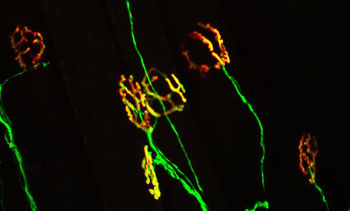Faulty Protein Interaction Disrupts Neuromuscular Junctions and Triggers ALS
By Gerald M. Slutzky, PhD
Posted on 01 Dec 2016
Humans and mice are protected from developing amyotrophic lateral sclerosis (ALS) by the action of muscle fibers that secrete and concentrate the fibroblast growth factor binding protein 1 (FGFBP1) at neuromuscular junctions.Posted on 01 Dec 2016
The FGFBP1 gene encodes a secreted fibroblast growth factor carrier protein, which plays a critical role in cell proliferation, differentiation, and migration by binding to fibroblast growth factors and potentiating their biological effects on target cells.

Image: The neuromuscular junction is the synapse where motor neurons communicate with muscle to initiate voluntary movement. A healthy neuromuscular junction (yellow) is characterized by perfect apposition between the motor neuron (green) and nicotinic acetylcholine receptors on the muscle (red). This synapse is damaged early in ALS, a change believed to contribute the onset and progression of the disease (Photo courtesy of the Virginia Tech Carilion Research Institute).
ALS is a specific disorder that involves the death of neurons. The disease, for which there is no cure, is characterized by stiff muscles, muscle twitching, and gradually worsening weakness due to muscles decreasing in size. Most ALS sufferers die from respiratory failure. The neuromuscular junction (NMJ) is critical for all voluntary movement. Its malformation during development and degeneration during aging or in ALS impairs motor function.
Investigators at the Virginia Tech Carilion Research Institute (Roanoke, VA, USA) reported in the November 14, 2016, online edition of The Journal of Neuroscience that while FGFBP1 expression increased during development, its expression decreased prior to NMJ degeneration during aging and in the SOD1G93A ALS mouse model. FGFBP1 expression was shown to be inhibited by increased accumulation of transforming growth factor-beta1 (TGF-beta1) in skeletal muscles and at their NMJs. When they examined the impact of deleting FGFBP1 on NMJs, the investigators found that in the absence of FGFBP1, NMJs exhibited structural abnormalities in developing and in middle age mice. Deletion of FGFBP1 from SOD1G93A mice also accelerated NMJ degeneration and death.
These findings suggested that targeting the interaction between FGFBP1 and TGF-beta1 signaling could hold promise for slowing age- and disease-related degeneration of NMJs.
"TGF-beta1 is upregulated in ALS and in turn blocks expression of FGFBP1, which is released by muscle fibers to preserve the integrity of the neuromuscular junction," said senior author Dr. Gregorio Valdez, assistant professor of biological sciences at the Virginia Tech Carilion Research Institute. "The body is trying to help itself by generating more TGF-beta1. Unfortunately, TGF-beta1 accumulates at the synapse where it blocks expression of FGFBP1, accelerating degeneration of the neuromuscular junction. Our findings suggest that targeting these molecules may allow these important synapses to stay in place, and slow the progression of ALS."
Related Links:
Virginia Tech Carilion Research Institute













